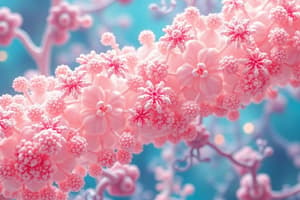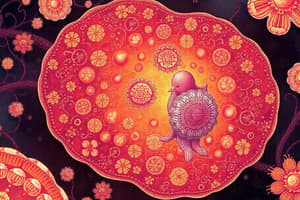Podcast
Questions and Answers
What is the primary function of the signal peptide in protein translocation?
What is the primary function of the signal peptide in protein translocation?
- To facilitate retrograde movement
- To initiate protein glycosylation
- To regulate protein degradation
- To target proteins to the ER for translocation (correct)
Why are pathogens, such as viruses, important in the study of cell biology?
Why are pathogens, such as viruses, important in the study of cell biology?
- They are dependent on cellular machinery for protein production and transport (correct)
- They are simple models for studying cellular processes
- They are only relevant to immunology, not cell biology
- They are easy to culture and manipulate
What is the enzyme responsible for removing the signal peptide during protein translocation?
What is the enzyme responsible for removing the signal peptide during protein translocation?
- Protease
- Glycosidase
- Peptidase
- Signal peptidase (correct)
What is the role of hydrophobicity in protein translocation?
What is the role of hydrophobicity in protein translocation?
What is the significance of cell biology in immunology?
What is the significance of cell biology in immunology?
What is the primary location where protein translocation and glycosylation occur?
What is the primary location where protein translocation and glycosylation occur?
What is the primary function of the secretory pathway during pathogen infection?
What is the primary function of the secretory pathway during pathogen infection?
Which of the following proteins is most likely to be embedded in the membrane?
Which of the following proteins is most likely to be embedded in the membrane?
What is the primary reason for transporting molecules in cells?
What is the primary reason for transporting molecules in cells?
Which of the following is NOT a function of the secretory pathway?
Which of the following is NOT a function of the secretory pathway?
What is the role of COPI and COPII proteins in intracellular transport?
What is the role of COPI and COPII proteins in intracellular transport?
How are proteins destined for the plasma membrane or secretion synthesised?
How are proteins destined for the plasma membrane or secretion synthesised?
What is the role of the ER in protein modification?
What is the role of the ER in protein modification?
How is intracellular transport mediated?
How is intracellular transport mediated?
Flashcards are hidden until you start studying
Study Notes
Intracellular Trafficking
- Intracellular trafficking refers to the movement of molecules within the cell
- Key components involved: COPI and COPII coat proteins, regulating anterograde and retrograde transport in the early secretory pathway
Protein Translocation and Glycosylation
- Signal sequence or signal peptide: a stretch of 12-16 hydrophobic amino acids at the N-terminus flanked by basic "charged" residues
- Signals and enzymes involved: signal peptidase removes the signal peptide after translocation into the ER
- Cellular location: Endoplasmic Reticulum (ER)
- Motifs: hydrophobic regions, signal sequence, and transmembrane domains
Importance of Intracellular Trafficking
- Pathogens exploit cellular machinery for protein production and transport
- Cell biology plays a crucial role in the location and detection of pathogens and the activation of immune response
- Secretory pathway is crucial during pathogen infection for protein production and localization
Virology and Immune Responses
- Release of virus particles involves the secretory pathway
- ER and Golgi apparatus are involved in protein modification during virus replication
- Immunoglobulin production and secretion occur through the secretory pathway
mRNA Vaccines
- Signals within the protein direct it to the secretory pathway and ultimately presented at the cell surface for immune surveillance
- Nanoparticle is taken into cells, and the mRNA is released and translated on host ribosomes
Transmembrane Proteins
- Proteins with additional hydrophobic regions can embed within the membrane
- Multiple "membrane spanning" or "transmembrane" domains may exist within a protein
- The greater the hydrophobicity of the protein, the greater the affinity for the membrane
Intracellular Transport
- Highly regulated and dynamic processes exist to move constituents in and out of the cell
- Reasons for transporting molecules in cells:
- Residency: proteins made in the ER may have a function elsewhere
- Secretion: molecules are expelled into the extracellular environment
- Required upon stimulation: e.g., hormone release
Secretory Pathway
- Used to move materials around the cell, including the plasma membrane and outside the cell
- Proteins destined for the PM, endosomes/lysosomes, or secretion are synthesized by the RER
- Contain specific amino acid sequences (signal sequences) which target them to the lumen of RER
Studying That Suits You
Use AI to generate personalized quizzes and flashcards to suit your learning preferences.



